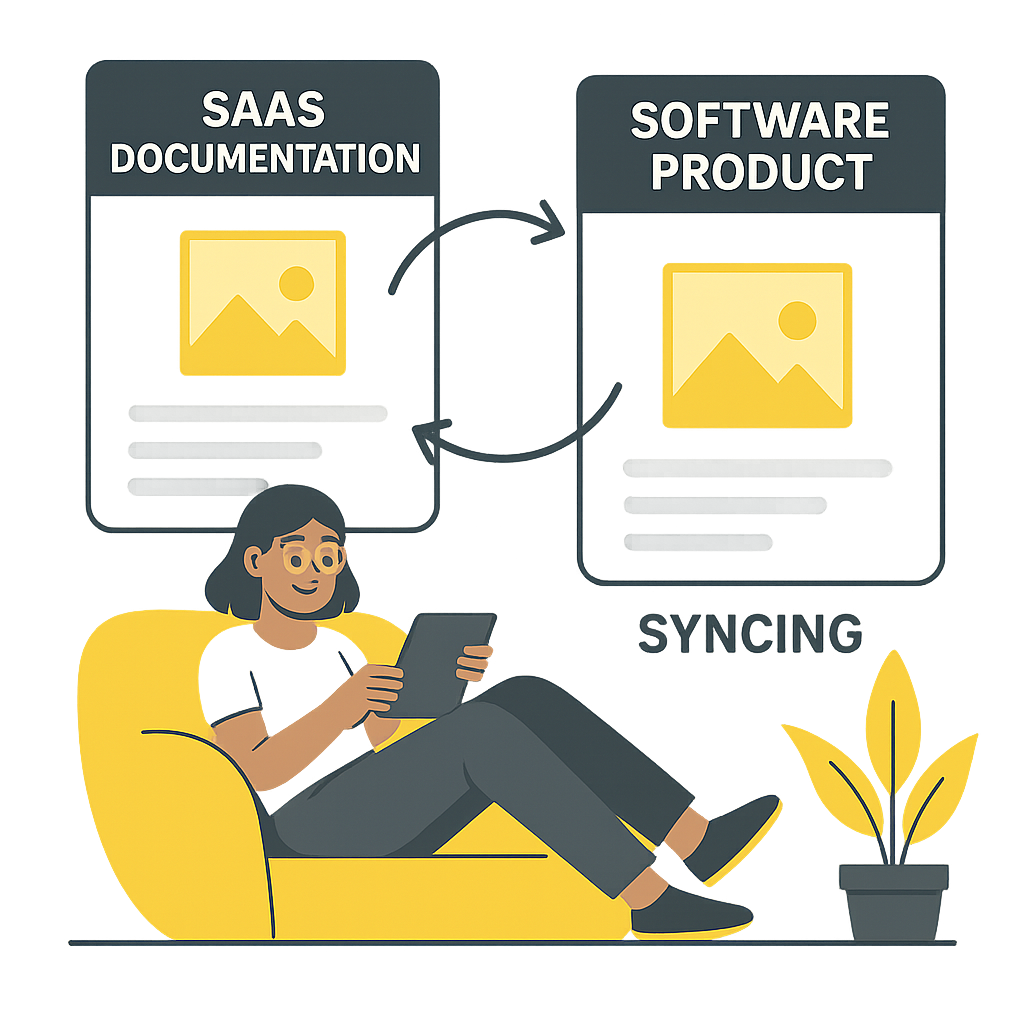Automate OutSystems Application Screenshots with FreshShots: Keep Low-Code Documentation Current

OutSystems enables rapid application development, but documenting these fast-changing applications is a nightmare. Applications evolve daily, but screenshots in documentation lag behind by weeks. FreshShots automatically captures and updates screenshots so your OutSystems documentation stays current with your application releases.
The OutSystems Documentation Challenge
OutSystems’ rapid development cycles create unique documentation challenges:
- Frequent releases: Applications change multiple times per week
- Manual screenshot process: Screen capture → crop → upload → repeat
- Documentation debt: Screenshots outdated within days of creation
- Cross-environment complexity: Different screenshots for Dev/Test/Prod
- Team coordination: Multiple developers = inconsistent documentation
How FreshShots Transforms OutSystems Documentation
FreshShots integrates seamlessly with OutSystems development workflows:
- Automatic capture: Screenshots generate from live applications
- Environment-aware: Separate workflows for each OutSystems environment
- Release integration: Trigger updates during OutSystems deployments
- Consistent quality: Same viewport and styling across all screenshots
- Global accessibility: CDN-hosted images accessible anywhere
Complete Setup Guide: FreshShots + OutSystems
Step 1: Prepare Your OutSystems Application
Add data-freshshots-id attributes to key UI elements in your OutSystems screens:
In Expression Widgets:
<div data-freshshots-id="customer-dashboard" class="dashboard-container">
In Rich Widgets:
<section data-freshshots-id="order-management" class="orders-panel">
For Reactive Web Applications:
<!-- Main screen content -->
<div data-freshshots-id="app-homepage" class="home-screen">
<!-- Your OutSystems content -->
</div>
<!-- Data grids and lists -->
<div data-freshshots-id="customer-list" class="table-records">
<!-- TableRecords widget content -->
</div>
<!-- Forms and inputs -->
<form data-freshshots-id="user-registration" class="form-container">
<!-- Input widgets -->
</form>
Step 2: Create Environment-Specific Workflows
Development Environment Workflow:
[
{
"action": "visit_page",
"url": "https://dev-yourapp.outsystemscloud.com/YourApp/"
},
{
"action": "take_screenshot",
"selector": "app-homepage",
"save_screenshot_to": "dev-homepage.png",
"viewport_size": { "width": 1366, "height": 768 }
},
{
"action": "visit_page",
"url": "https://dev-yourapp.outsystemscloud.com/YourApp/customers"
},
{
"action": "take_screenshot",
"selector": "customer-list",
"save_screenshot_to": "dev-customer-management.png"
}
]
Production Environment Workflow:
[
{
"action": "visit_page",
"url": "https://yourapp.outsystemscloud.com/YourApp/"
},
{
"action": "login_outsystems",
"username": "[email protected]",
"password": "secure_password"
},
{
"action": "take_screenshot",
"selector": "customer-dashboard",
"save_screenshot_to": "prod-dashboard.png"
},
{
"action": "visit_page",
"url": "https://yourapp.outsystemscloud.com/YourApp/orders"
},
{
"action": "take_screenshot",
"selector": "order-management",
"save_screenshot_to": "prod-order-screen.png"
}
]
Step 3: Document Different User Roles
OutSystems applications often have role-based access. Capture screenshots for each user type:
Admin User Documentation:
[
{
"action": "visit_page",
"url": "https://yourapp.outsystemscloud.com/YourApp/login"
},
{
"action": "type_input",
"selector": "Input_Email",
"input_value": "[email protected]"
},
{
"action": "type_input",
"selector": "Input_Password",
"input_value": "admin_password"
},
{
"action": "click_element",
"selector": "Button_Login"
},
{
"action": "take_screenshot",
"selector": "admin-dashboard",
"save_screenshot_to": "admin-view.png"
},
{
"action": "visit_page",
"url": "https://yourapp.outsystemscloud.com/YourApp/admin/users"
},
{
"action": "take_screenshot",
"selector": "user-management",
"save_screenshot_to": "admin-user-management.png"
}
]
End User Documentation:
[
{
"action": "visit_page",
"url": "https://yourapp.outsystemscloud.com/YourApp/login"
},
{
"action": "type_input",
"selector": "Input_Email",
"input_value": "[email protected]"
},
{
"action": "type_input",
"selector": "Input_Password",
"input_value": "user_password"
},
{
"action": "click_element",
"selector": "Button_Login"
},
{
"action": "take_screenshot",
"selector": "user-dashboard",
"save_screenshot_to": "enduser-view.png"
}
]
Step 4: Integrate with OutSystems Deployment Pipeline
LifeTime Integration:
Add FreshShots to your OutSystems deployment process:
# In your CI/CD pipeline (Azure DevOps, Jenkins, etc.)
- name: Deploy to OutSystems
run: |
# Your OutSystems deployment commands
outsystems-deploy --app YourApp --env Production
- name: Update Documentation Screenshots
run: |
# Wait for deployment to complete
sleep 60
# Trigger FreshShots workflows
curl -X POST https://api.freshshots.io/v1/run/123 \
-H "x-api-key: ${{ secrets.FRESHSHOTS_API_KEY }}" \
-H "Content-Type: application/json" \
-d '{"environment": "production"}'
OutSystems Forge Component Integration:
Create a custom component to trigger FreshShots:
// In your OutSystems application
public void TriggerDocumentationUpdate()
{
var httpClient = new HttpClient();
httpClient.DefaultRequestHeaders.Add("x-api-key", Site.Properties.FreshShotsApiKey);
var response = httpClient.PostAsync(
"https://api.freshshots.io/v1/run/" + Site.Properties.WorkflowId,
new StringContent("{}", Encoding.UTF8, "application/json")
).Result;
if (response.IsSuccessStatusCode)
{
// Log success or trigger notification
Logger.Debug("Documentation screenshots updated successfully");
}
}
Advanced OutSystems Documentation Techniques
Mobile App Screenshots
For OutSystems mobile applications:
{
"action": "take_screenshot",
"selector": "mobile-app-container",
"save_screenshot_to": "mobile-dashboard.png",
"viewport_size": { "width": 375, "height": 812 },
"device_type": "mobile",
"image_zoom": 2
}
Progressive Web App (PWA) Documentation
Capture PWA-specific features:
[
{
"action": "visit_page",
"url": "https://yourapp.outsystemscloud.com/YourApp/"
},
{
"action": "simulate_offline",
"enabled": true
},
{
"action": "take_screenshot",
"selector": "offline-message",
"save_screenshot_to": "pwa-offline-state.png"
},
{
"action": "simulate_offline",
"enabled": false
}
]
Form Validation Documentation
Document OutSystems form validation:
[
{
"action": "visit_page",
"url": "https://yourapp.outsystemscloud.com/YourApp/register"
},
{
"action": "click_element",
"selector": "Button_Submit"
},
{
"action": "take_screenshot",
"selector": "registration-form",
"save_screenshot_to": "form-validation-errors.png"
},
{
"action": "type_input",
"selector": "Input_Email",
"input_value": "[email protected]"
},
{
"action": "type_input",
"selector": "Input_Password",
"input_value": "ValidPassword123"
},
{
"action": "take_screenshot",
"selector": "registration-form",
"save_screenshot_to": "form-valid-state.png"
}
]
Documentation Organization Strategies
Environment-Based Structure
# Application Documentation
## Development Environment

*Development environment for testing new features*
## Staging Environment

*Pre-production testing environment*
## Production Environment

*Live application used by end users*
User Role Documentation
# User Guides by Role
## Administrator Guide

### User Management

## End User Guide

### Daily Workflows

Feature-Based Documentation
# Feature Documentation
## Customer Management

### Adding New Customers

### Customer Details

OutSystems-Specific Best Practices
Screen Naming Conventions
Follow OutSystems naming patterns in your screenshots:
- Screen names:
CustomerList_Screenshot.png - Action flows:
CreateCustomer_Flow.png - Popup screens:
CustomerDetail_Popup.png - Mobile screens:
Mobile_CustomerList.png
Widget-Level Documentation
Document specific OutSystems widgets:
{
"action": "take_screenshot",
"selector": "TableRecords_Customers",
"save_screenshot_to": "tablerecords-widget.png",
"highlight_element": true,
"padding": 20
}
Theme and Style Guide Documentation
Capture your OutSystems theme implementation:
[
{
"action": "visit_page",
"url": "https://yourapp.outsystemscloud.com/YourApp/styleguide"
},
{
"action": "take_screenshot",
"selector": "color-palette",
"save_screenshot_to": "theme-colors.png"
},
{
"action": "take_screenshot",
"selector": "button-styles",
"save_screenshot_to": "theme-buttons.png"
}
]
Integration with OutSystems Development Tools
Service Studio Integration
Add documentation reminders in Service Studio:
// Add as a comment in your screen logic
/*
DOCUMENTATION:
Screenshot automatically captured by FreshShots
URL: https://cdn.freshshots.io/1/customer-dashboard.png
Last Updated: Automated via deployment pipeline
*/
Integration Studio Components
Create reusable components for documentation:
public class DocumentationHelper
{
public static void TriggerScreenshotUpdate(string screenName)
{
// Trigger FreshShots workflow for specific screen
var workflowId = GetWorkflowId(screenName);
TriggerFreshShotsWorkflow(workflowId);
}
private static void TriggerFreshShotsWorkflow(string workflowId)
{
// Implementation to call FreshShots API
}
}
Measuring Documentation ROI
Before FreshShots (OutSystems)
- Documentation time: 8-12 hours per sprint
- Accuracy: 40% of screenshots outdated
- Developer overhead: 20% time on documentation
- User training: Frequent confusion due to UI mismatches
After FreshShots (OutSystems)
- Documentation time: 1 hour initial setup, then automated
- Accuracy: 100% current screenshots
- Developer focus: 95% time on feature development
- User satisfaction: Seamless experience with current documentation
Troubleshooting OutSystems + FreshShots
Authentication Issues:
- Verify OutSystems user credentials
- Check session timeout settings
- Ensure proper role assignments
Screen Loading Problems:
- Add wait conditions for AJAX-heavy screens
- Increase page load timeouts
- Handle OutSystems loading indicators
Mobile App Challenges:
- Use appropriate device viewports
- Account for OutSystems mobile navigation
- Handle app-specific gestures
Getting Started Checklist
- Sign up for FreshShots (free tier available)
- Add data attributes to 5-10 key OutSystems screens
- Create workflows for each environment (Dev/Test/Prod)
- Test screenshot capture on a sample screen
- Integrate with deployment pipeline
- Update documentation with CDN URLs
- Train development team on new workflow
- Set up monitoring for screenshot freshness
OutSystems-Specific Features
Reactive vs. Traditional Web
FreshShots works with both OutSystems application types:
- Reactive Web: Modern responsive applications
- Traditional Web: Classic server-side applications
- Mobile Apps: Native and PWA applications
Multi-Tenant Applications
Capture screenshots across different tenants:
{
"action": "visit_page",
"url": "https://tenant1.yourapp.outsystemscloud.com/YourApp/",
"tenant_context": "tenant1"
}
Custom CSS Integration
Document custom styling:
{
"action": "take_screenshot",
"selector": "custom-component",
"save_screenshot_to": "custom-styles.png",
"apply_css": ".highlight { border: 2px solid #007bff; }"
}
Ready to automate your OutSystems documentation? Start your free FreshShots account and eliminate manual screenshot management from your development workflow.
Need help integrating FreshShots with your specific OutSystems environment? Contact our team for enterprise support and custom setup assistance.

